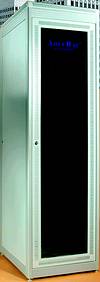

The company is growing and so is the network. Not sure where to keep all your network equipment? Cabinets not only organise one's equipment and cabling neatly, but also keep it secure behind locked doors.
Jerome Mentoor of Falcon Electronics provides the following advice.
Cabinets come in all sizes - do-it-yourself or preassembled - and also in a choice of colours. One of the most important things is to make sure you get the right cabinet for your equipment. By first spending a little time planning, a lot of aggravation is avoided later.
Measure everything: Vertical space in racks is usually measured in 'rack units'. One rack unit (1U) equals 1,75 inches or 44,45 mm. Add up the heights of all the equipment (there are even special tape measures marked in rack units). It may be advisable to consider adding extra height for future expansion. Also, note the depth of the deepest piece of equipment and the width of the widest piece of equipment. The industry-standard widths for mounting rails are 19, 23, and 24".
Plan for security: If security is an issue choose a cabinet with a locking front and back door - and keep the keys in a safe place.
Add shelves and mounting hardware: Some devices can be mounted directly in cabinets, either by themselves or with optional mounting hardware. If equipment cannot be mounted that way, it will have to sit on a shelf. When selecting a shelf, determine how much weight the shelf would support, and choose a shelf rated for more than that. Shelves can be solid, vented, sliding, or stationary. They are usually designed to fit specific cabinets or racks.
Add the accessories needed: Some accessories may be absolutely essential for installation. Others just make life easier. Either way, it is best to install everything at the beginning instead of having to take the cabinet apart again later.
Are fans required?: Equipment locked in a cabinet can easily overheat. Fans keep the air circulating and the temperature down. Then fit specific cabinets and racks. Ensure the right model is ordered.
Uninterruptible power supplies: A UPS keeps the power on during a short power blackout or brownout, and gives time to shut down equipment properly during a longer one. Standalone and rack-mount UPSs are available.
Cable management: Most cabinets have some type of cable management as a standard feature, but installations with a lot of cables might need extra ring brackets, management panels, and rack mount cable raceways.
Power strips: Power strips are a necessity in a cabinet or rack. They come in horizontal or vertical rack mount versions. Some power strips also have built-in surge protection. Many cabinets come with power strips, but make sure to order one if the cabinet ordered does not come with one.
Ready to 'fill 'er up'
The last step - after the cabinet is put together - is installing all the equipment. Keep the installation neat and lay out the equipment so all the controls can be easily reached. Use the cable-management accessories to keep cables organised and out of the way. If one plans well now, rearrangement of the cabinet will not be required every time equipment is added.
For more information contact Jerome Mentoor, Falcon Electronics, 011 624 1270.

© Technews Publishing (Pty) Ltd | All Rights Reserved